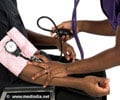Data unveiled today at the American Society of Hypertension's Twenty Fourth Annual Scientific Meeting (ASH 2009) revealed that ambulatory blood pressure (ABP) monitoring and staging
Data unveiled today at the American Society of Hypertension's Twenty Fourth Annual Scientific Meeting (ASH 2009) revealed that ambulatory blood pressure (ABP) monitoring and staging can more accurately predict a child's risk for left ventricular hypertrophy (LVH), a precursor to cardiovascular disease (CVD), than current diagnostic methods using casual blood pressure measurements. Although previous studies have shown an association between LVH and hypertension, this is the first to assess the correlation when blood pressure (BP) is classified by stages of ABP. The findings have distinct implications for the risk management of CVD in both children and adolescents with high blood pressure.
Lead author of the study, Alisa Acosta, M.D., Department of Pediatrics, Division of Pediatric Nephrology and Hypertension, University of Texas Medical School at Houston said, "In recent years, pediatric practitioners have increasingly used ambulatory blood pressure monitoring for evaluating blood pressure abnormalities in children. Yet despite its growing popularity, a number of areas where ABP monitoring may be valuable for the clinical evaluation of children with BP abnormalities have remained unexplored."A total of 241 children (aged 8-18) were included in the retrospective study. The mean age of participants was 12.9 years and the majority were male (67 percent). Participants were grouped by 24hr ABP according to a modified version of the 2008 American Heart Association ambulatory BP schema and by casual BP alone. LVH was defined by a left ventricular mass indexed by height (LVMI). The ABP groups were divided as follows: 19.1 percent normotensive; 17 percent white coat hypertension; 11.6 percent masked hypertension; 22.4 percent pre-hypertension; 5.8 percent ambulatory hypertension; and 24.1 percent severe ambulatory hypertension. The ambulatory BP groups differed by race and BMI with the normal BP group having the lowest BMI percentile.
LVMI increased across the groups from normal to severe ambulatory hypertension (p < 0.05), and LVH was significantly associated with ambulatory BP stages (p = 0.01), but not when classified by casual BP alone. Stage 2 HTN by casual BP did predict LVH, but after adjusting for BMI, the relationship was not significant. Severe ambulatory hypertension was also a significant predictor of LVH and this relationship remained significant after adjusting for age, gender, race and BMI.
The study showed a significant association between severe ambulatory hypertension and LVH in children and adolescents independent of age, gender, race and BMI, yet this same relationship was not detected when participants were classified according to casual blood pressures alone.
"Hypertensive hypertrophy of the heart is a precursor to cardiovascular events," said Dr. Acosta. "Staging of ambulatory blood pressure to identify those at highest risk for LVH will allow for early treatment and ideally delay the onset of cardiovascular disease."
Source-Newswise
SRM














